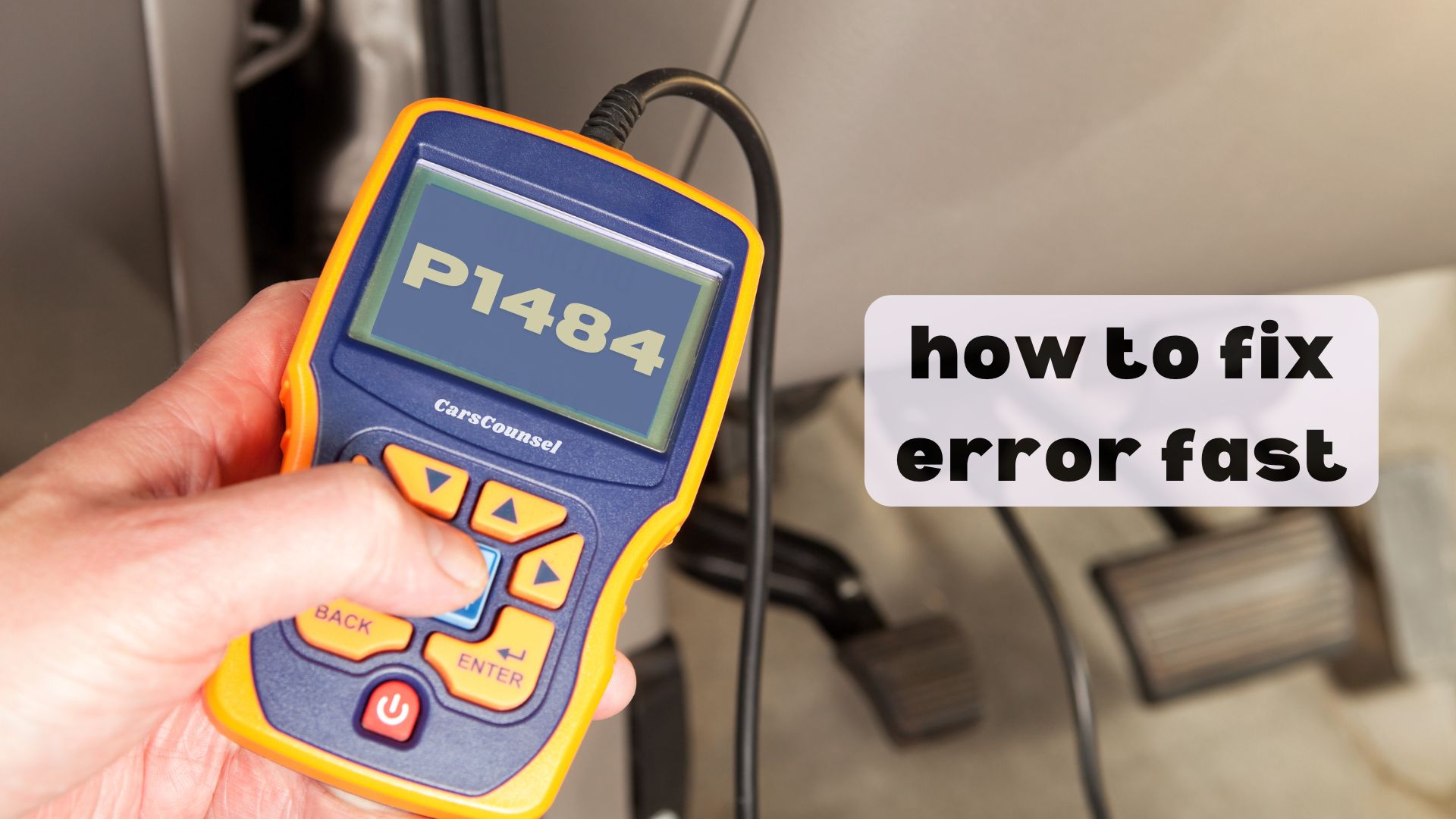When your onboard computer triggers a P1484 code, it’s alerting you to a malfunction in the cooling fan RPM signal. This means your cooling system is at risk of inefficient cooling, which can lead to engine overheating. You might notice abnormal fan sounds, a lit check engine light, or poor air conditioning performance. But what’s causing this issue? Is it a faulty relay switch, wiring problems, or a malfunctioning cooling fan control module? You’ll need to investigate further to prevent potential engine damage.

Quick Navigation
Key Takeaways
- The P1484 code indicates a malfunction in the cooling fan RPM signal, which can lead to inefficient cooling and engine overheating.
- Common causes include faulty relay switch, electrical surge events, wiring or connection issues, and malfunctioning cooling fan control module.
- Abnormal sounds from the fan, check engine light illumination, poor air conditioning performance, and overheating are common symptoms of P1484.
- To diagnose the issue, use diagnostic tools to examine the cooling fan’s RPM signal and identify the root cause of the malfunction.
- Repairing a P1484 code can be costly, ranging from $150 to $600, depending on the underlying cause and labor rates in the area.
Code P1484 Description
When your vehicle’s onboard computer detects a malfunction in the cooling fan RPM signal, it triggers the diagnostic trouble code P1484.
This trouble code indicates a problem with the cooling system, which can lead to inefficient cooling and potential engine overheating.
A problem with the cooling system can lead to inefficient cooling and potential engine overheating.
The cooling fan plays a vital role in regulating engine temperature, so it’s essential to address this issue promptly.
To diagnose the problem, you’ll need to use diagnostic tools to examine the cooling fan’s RPM signal and identify the root cause of the malfunction.
Common Causes of P1484
The cooling fan RPM signal malfunction indicated by code P1484 can stem from several sources. You’ll need to identify the root cause to fix the issue. Some common causes to ponder:
| Cause | Description |
|---|---|
| Faulty relay switch | A malfunctioning relay switch can prevent the cooling fan from receiving the proper signal, leading to a faulty RPM reading. |
| Electrical surge events | A sudden electrical surge can damage the cooling fan motor or control module, causing the RPM signal to malfunction. |
| Wiring or connection issues | Corrosion, damage, or loose connections in the cooling fan circuit can disrupt the RPM signal. |
| Malfunctioning cooling fan control module | A faulty control module can send incorrect signals, resulting in a malfunctioning cooling fan. |
Symptoms of P1484
Your vehicle’s engine relies on proper cooling to function efficiently, and a malfunctioning cooling fan RPM signal can throw a wrench in the works.
When this happens, you may notice abnormal sounds from the fan, such as unusual fan noise or grinding sounds. The check engine light will likely illuminate on your dashboard, and you may experience poor air conditioning performance.
Overheating is also a common symptom, which can lead to increased engine noise due to overheating. Additionally, the cooling fan may not turn on or run at abnormal speeds, further exacerbating the issue.
How to Fix P1484
Diagnosing and repairing a P1484 code requires a systematic approach to identify the root cause of the malfunction.
You’ll need to use diagnostic tools to check the fan speed and RPM signal. Start by inspecting the cooling fan motor and circuit for any signs of damage or corrosion.
Check the coolant temperature sensor and fan control module for proper function. If you find any issues, replace the faulty components.
Finally, perform a diagnostic scan to check for any software or programming issues in the engine control module.
Addressing these potential causes will help you fix the P1484 code and get your vehicle running smoothly again.
Cost to Fix P1484
Repairing a P1484 code can be costly, but the exact expense depends on the underlying cause of the malfunction and the labor rates in your area.
You can expect to pay between $50 and $300 for parts, and labor costs may range from $100 to $300.
To get a more accurate repair estimate, consult with a trusted mechanic or repair shop, as they’ll need to diagnose the issue using diagnostic tools. They’ll provide you with a detailed breakdown of the repair costs and recommend the best course of action.
Cooling Fan Function and Importance
The cooling fan plays a vital role in maintaining your engine’s ideal operating temperature, ensuring that it runs smoothly and efficiently.
By creating a consistent airflow, the fan helps to dissipate heat generated during engine operation. This airflow dynamics are critical to fan efficiency, allowing the engine to operate within a safe temperature range.
If the fan fails to function properly, engine performance will suffer, and overheating can occur. As you can see, a properly functioning cooling fan is essential to preventing damage to your engine and ensuring peak performance.
Malfunctioning Cooling Fan Motor
A faulty cooling fan motor can be a significant contributor to the P1484 code, and it’s essential to identify the problem early on to prevent engine damage.
When analyzing fan failure, you’ll want to inspect the motor for signs of wear, corrosion, or overheating. If you find any issues, it’s vital to replace the motor promptly.
Motor Replacement Tips: verify the new motor is compatible with your vehicle’s make and model, and follow the manufacturer’s installation instructions carefully. Remember to test the fan after replacement to confirm it’s operating within the expected RPM range.
Wiring and Connection Issues
One common culprit behind the P1484 code is wiring or connection issues in the cooling fan circuit.
You’ll need to inspect the wiring harness for signs of damage, wear, or corrosion. Faulty connectors or corroded wires can disrupt the signal, causing the code to trigger.
Check for loose or broken connections, and make sure all wires are properly secured. Corroded wires should be replaced, and connectors should be cleaned or replaced if necessary.
A thorough inspection and repair of the wiring and connections can resolve the issue and get your cooling fan running smoothly again.
Cooling Fan Control Module Failure
Faulty control modules can masquerade as other issues, making diagnosis challenging.
When you suspect a cooling fan control module failure, look for signs like inconsistent fan speeds or failure to turn on. Check for electronic faults, such as short circuits or corrosion, which can trigger the P1484 code.
If you’ve ruled out other causes, it’s likely the module itself is faulty. In this case, module replacement is the most effective solution. Be sure to consult your vehicle’s repair manual or a trusted mechanic for guidance on replacing the module and resolving the electronic fault.
Engine Overheating Consequences
When your engine overheats, it can lead to a cascade of damaging consequences that can leave you stranded on the side of the road.
Overheating damage can cause engine components to warp, crack, or seize, resulting in costly repairs. If your engine seizes, it may require a complete overhaul or even replacement.
Additionally, overheating can lead to premature wear on moving parts, reducing your engine’s lifespan.
Furthermore, it’s essential to address the P1484 code promptly to prevent these devastating consequences. Don’t wait until it’s too late – have your vehicle inspected and repaired by a qualified mechanic as soon as possible.
More OBD-II Codes
| P1485 | P1486 | P1291 | P1292 |
| P1293 | P1294 | P1226 | P1209 |
| P1210 | P1204 | P1202 | P1203 |
| P1198 | P1146 | P1145 | P1144 |
| P1143 | P1142 | P1140 | P1139 |
| P1141 | P1138 | P1137 | P1222 |
Frequently Asked Questions
Can I Drive My Car With the P1484 Code?
When your car’s fan operation is impaired, driving safety is compromised, and you risk overheating, engine damage, and costly repairs; it’s not recommended to drive your car until the issue is resolved to guarantee your safety on the road.
Will a Malfunctioning Cooling Fan Affect My Car’s Fuel Efficiency?
You’ll likely notice changes in fuel consumption patterns if your cooling fan malfunctions, as a struggling engine will guzzle more gas. Conduct engine performance checks to identify the root cause, as a faulty fan can lead to decreased fuel efficiency.
Can a Faulty Coolant Temperature Sensor Cause Other Issues?
You’ll likely encounter issues beyond cooling fan malfunction if your coolant temperature sensor is faulty, as it can provide faulty readings, leading to sensor failure that affects engine performance, air conditioning, and potentially even transmission operation.
How Often Should I Inspect My Cooling Fan for Maintenance?
You should inspect your cooling fan every 30,000 miles for maintenance, checking for fan noise, ensuring electrical connections are secure, and verifying proper fan operation to prevent overheating and expensive repairs.
Can a Software Update Fix the P1484 Code Issue?
Can a software update be the silver bullet for your cooling fan woes? Yes, a software patch can fix the issue if it’s related to the fan control module, but don’t rule out hardware problems just yet, you’ll need to diagnose further to be sure.
Conclusion
When your car’s cooling system is on the fritz, it’s like a fire burning out of control – it can quickly spiral out of hand. Don’t let a P1484 code simmer in the background, as engine overheating can lead to catastrophic damage, costing you thousands in repairs. By addressing the faulty relay switch, wiring issues, or malfunctioning control module, you can prevent a minor issue from becoming a major headache. Take control of your car’s cooling system before it’s too late.

